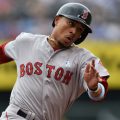This article is one in a series that uses the FantasyLabs Tools to build daily fantasy scouting reports for MLB lineups.
Last year the Detroit Tigers finished 15th in average player DraftKings points per game with a collective 0.0 Plus/Minus. That’s about as boring as it gets. But the roster survived a time of turmoil during which it was debated at length whether the team would be best served to retool or rebuild. In reality, they took the ‘do nothing’ approach, but that’s probably closer to ‘retool’ on the spectrum. Returning all of the key hitters without any notable additions, the Tigers will hope that 2016 was a down year and they can get back into playoff contention in 2017.
Handedness
In each split, the Tigers’ 2016 numbers are decent. Against righty pitching, they finished third in batting average and eighth in home runs. Against lefties, they finished 11th in average and fourth on home runs. So why did they have lackluster fantasy results? The problem in 2016 was that the Tigers were a known commodity. Their best players have been solid for several years, they have made few changes, and it was easy for sites to price their players appropriately. Miguel Cabrera led the team last year in overall Plus/Minus, adding 118.6 points above salary-implied expectations. That was good enough for 22nd in the league overall even though Cabrera was sixth in on-base plus slugging.
Although the raw numbers looked fine, the Tigers were dreadful against lefties from a Plus/Minus perspective last season. Only Cabrera added more than 30 points above salary-implied expectations over the season against lefties, while key batters like Ian Kinsler and Victor Martinez finished with negative marks.
The 2016 Tigers were a notoriously right-handed bunch, so it made a lot of intuitive sense to stack them against lefties, but from a DFS perspective their ability against lefties was already priced in their salaries and so the Tigers fell short. Over their careers, the primary Detroit hitters do have mild-to-moderate splits that favor lefty matchups, most notably Justin Upton and Kinsler. If you’d like to screen for games this season in which these players face lefty pitching with reasonable salaries relative to their average salaries, this can be done by combining the “Player Name,” “Opp Pitcher Throws,” and “Salary Change” filters in our Trends tool.
Against righty pitching, the Tigers were very viable in 2016, led by Kinsler, Cabrera, and Cameron Maybin, one of the few Tigers who will not return to the team in 2017. In addition to scoring more fantasy points against righties, a Cabrera-Kinsler-Martinez-Upton stack was also lower-owned against righties than lefties by two full percentage points in 2016. Some DFS players don’t like to stack righties against righties, but the numbers suggest that stacking Detroit righties in 2017 against right-handed pitchers could be a smart contrarian move. Stacks can easily be incorporated into rosters with our Lineup Builder in our Player Models.
Pitcher Types
Here’s one area where the Tigers should be given credit: They were great against hard-throwing pitchers last season, ranking seventh in Plus/Minus against pitchers whose average fastball velocities exceeded 95 miles per hour:

As an added bonus, the ownership numbers were low for the Tigers when they faced hard-throwing pitchers. Pro subscribers should monitor ownership in this situation with our DFS Ownership Dashboard. If the ownership for Tigers batters continues to trail performance in 2017, they could offer great tournament value.
An unlikely hero, Nick Castellanos, lead the Tigers in average and total Plus/Minus on 61 percent Consistency against hard-throwing pitchers. In fact, dating back to 2015 Castellanos has averaged a +1.35 Plus/Minus in 45 of these games, nearly a point and a half per game higher than his baseline Plus/Minus.
As good as the Tigers were against high-velocity pitchers last year, they were equally poor against control pitchers, finishing 2016 with the fifth-worst Plus/Minus against pitchers whose fastball velocities were below 93 miles per hour. Here, the Plus/Minus plummeted while ownership soared:

There’s no guarantee that we will see the same results in 2017, but since the Tigers will field a similar lineup it’s a trend to keep an eye on as we move forward.
Results were similarly polarized for the Tigers against ground ball and fly ball pitchers in 2016. Against fly ball pitchers (35 percent FB rate or higher), the Tigers’ +0.6 DraftKings Plus/Minus was sixth in MLB. Against ground ball pitchers (45 percent GB rate or higher), they tied for fifth worst at -0.3. J.D. Martinez was a notable outlier — he did very well against groundball pitchers (+1.4) – but he is the only Tiger who sticks out in this regard.
Comerica Park
As a team, the Tigers have fielded a relatively home/away-agnostic lineup over the past three seasons. For all right-handed bats, Comerica Park has added the seventh-most value since 2014, but its -0.3 Plus/Minus for all lefty bats ranks eighth worst. The Tigers are a righty-heavy bunch, so you’d think they’d perform better at home, but that hasn’t been the case: Yhey have been slightly better on the road and more highly owned at home.
Vegas
The Tigers followed normal Vegas conventions for the most part last year with one exception. Castellanos, ever the contrarian, posted a -0.9 DraftKings Plus/Minus in games in which the team’s Vegas Score rated in the top third and a +7.1 in the seven games he played in with a bottom-third Vegas Score. Castellanos’ Vegas and pitcher-type performance is notable because 1) he may be best left off Tigers stacks (assuming you are stacking the Tigers in optimal settings), and 2) he can be used as a great standalone option in contrarian settings.
Conclusion
The 2017 Tigers are as close to a known commodity as we may find early in the season. Every single player projected to be in the Opening Day starting lineup was with the team in 2016. Given the familiarity, we probably have a better feel for where their players should be priced, which is both good and bad. It’s bad because maybe we won’t see as many values here as we’ll find elsewhere around the league in April, but it’s good because we can more confidently leverage the “Salary Change” and “Bargain Rating” filters via our Trends tool to invest in the right bats when they are on sale.





